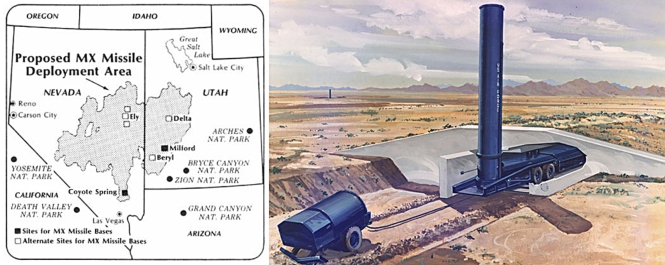Nuclear war is not amusing when it comes to your own backyard. At the height of the Cold War with the Soviet Union, in 1986, a new missile, the MX, (ironically nicknamed the Peacekeeper), was beginning to be deployed by the U.S. Air Force. Each missile contained 10 separate nuclear warheads that could be individually targeted. Where to put these deadly missiles was hotly debated. Regular fixed and hardened ground silos were thought to be unsafe, so a new idea was developed. Each one of the proposed 200 missiles would be placed on a 15-mile closed road loop with 23 bomb-proof shelters each separated by a distance not less then 7,000 feet to make sure that a single Soviet warhead could not destroy more then one shelter at a time. Periodically the missiles would be shuttled from one shelter to another within the loop in an elaborate and expensive shell game.
Where to put the 200 so-called ‘racetracks,’ was an easy choice, Nevada and Utah, (where I live), held millions of unoccupied acres of desert wilderness, so no one would mind if it was dug up for the MX shelters or destroyed in a nuclear exchange. The total deployment area would be some 45,000 square miles along with 10,000 miles of roads connecting the shelters. The construction would use scarce desert resources, depleting ground water reserves and closing large areas to public recreation and grazing for cattle ranchers. While regular people were somewhat receptive to the need to defend the country, the governors of Nevada and Utah along with the LDS Church and some U.S. senators, opposed the missile hiding idea. Eventually the scheme was discarded as being wasteful. Other suggestions were to put missiles in large boxcars and have them moved around on a small rail system in order to confuse the Russians. If needed, the missiles could also travel around the 200,000 miles of the regular U.S. rail system. The Peacekeeper Rail Garrison was started but never finished and in 1991, the project was canceled. The MX program had cost up to $20 billion by 1989 and produced 114 missiles at about $400 million for each one, and over $50 million for each warhead. By 2005 all had been decommissioned.
When the Soviet Union collapsed at the end of 1991 the Cold War seemed to have ended. The $7 trillion dollar U.S. price tag now seems to have been wasted as most of the weapons systems developed to oppose the Communists are now long since obsolete. As we get further from those days of nuclear paranoia, it is hard to imagine the necessity of spending so much money to try to destroy someone else. However, with so many left-over nuclear weapons around the world now, it has become much more worrying that terrorists and other disaffected groups could possibly get and use these old weapons. So governments will continue to spend extravagant amounts of money for our continued protection. The process goes onward with absolutely no end in sight.
(The map shows where vast acres would be required to hide the 200 nuclear tipped missiles and one of the proposed shelters. Fortunately the project was never started and the need to rip up and desecrate the desert was left for the locals to do now.)

